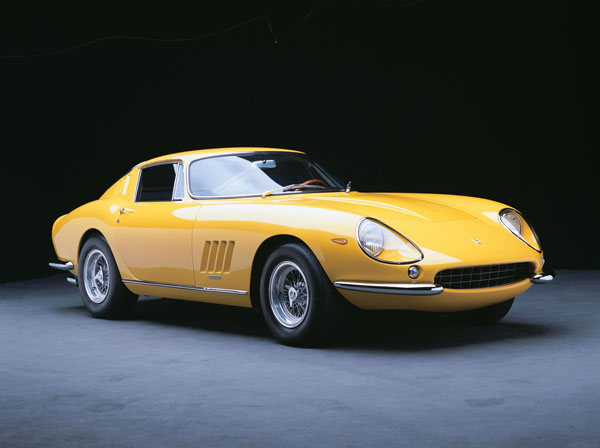

Ferrari’s two-seater Gran Turismo Berlinetta models were considered classics and the first model in the family was the 275. It was from this series of models that the marque’s later supercars developed. With a body by Pininfarina it introduced new features not previously seen in road-going Ferraris such as all-independent suspension and a five-speed gearbox mounted as a single unit together with the final drive so as to counterbalance the extreme forward positioning of the engine.
First shown at the 1964 Paris Motor Show the Ferrari 275 featured a twin-OHV longitudinally-mounted V12 engine and came in both coupe and convertible body styles. The engine was the ultimate enlargement of the Colombo-originated 60-degree V12 water-cooled engine with the bore of the light alloy block enlarged to 77 mm so as to give a capacity of 3286 cc. In the standard model three Weber twin-choke carburettors were used and produced 209 kW at 7600 rpm. At extra cost it was possible for buyers to specify the six twin-choke Weber 40DCN option which raised the output to 224 kW at 8000 rpm, giving a maximum speed of 260km/h and capable of accelerating from 0-100 km/h in a little over six seconds.
The all-independent suspension comprised double wishbones and coil springs at the rear as well as the front. These were mounted on sub-assemblies that, together with ladder cross-bracing, straddled two substantial tubular members which formed the chassis. The body sat on outrigger members also attached to the two main members. Whilst Pininfarina styled both bodies they only built the 275GTB coupes. The 275GTS convertible bodies were built by Scaglietti, who had a long association with Ferrari.
This chassis construction worked quite well with the coupe model since the steel body helped keep the body taut, but in the convertibles and the GTB/C competition cars which had alloy bodies this was not the case and gave rise to several problems. One of these, vibrations from the propeller shaft, was finally fixed by adding a torque tube with a centre bearing to support the shaft. The front end lift at high speeds was not due to chassis problems but was cured after wind tunnel tests by slightly extending the nose.
In 1966 the upgraded GTB/4 was released. It featured a four-cam version of the V12 engine with a 224 kW output, wider wheels and a ZF limited-slip differential replacing the Ferrari unit as well as small detail improvements. It was not until the Daytona model, a more or less successor to the 275, was released that the car featured improved brakes and an upgrade in cockpit trim and fittings.








